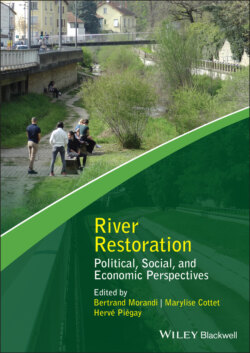Читать книгу River Restoration - Группа авторов - Страница 20
1.4 A research field tackling several topics
ОглавлениеAmong the publications in the field of river restoration, those devoted to societal issues are distinguished by a specific lexicon (Figure 1.5). The qualitative analysis of these publications makes it possible to reduce the apparent thematic diversity and to schematically draw three main lines of research.
1 The first brings together research on human–river interactions. The public’s environmental perceptions and preferences as well as social practices are often central to this first corpus of 53 publications. Analysis of the different links that individuals have with rivers, of their consideration within the framework of projects, or the way they are impacted by restoration measures, constitutes a first important challenge for researchers.Figure 1.4 Map of the study sites of international research publications on societal issues in river restoration (1992–2019).Figure 1.5 A lexicon specific to international scientific publications on the societal stakes in river restoration.
2 A second thematic corpus, composed of 38 publications, focuses more specifically on the political issues raised by the implementation of restoration projects. The analysis of governance and the roles played by the different actors involved in restoration projects structures the work in this corpus. In particular, the issue of public participation is at the heart of much of the work.
3 Finally, economic approaches structure a third problematic corpus consisting of 66 articles. Economic evaluations of restoration projects, sometimes based on cost–benefit analyses, are central to this work. Notably, strong methodological attention is paid to the evaluation of nonmarket ecosystem services restored by restoration projects.
These different thematic fields are not independent. Understanding environmental perceptions, for example, is often a first step in the political analysis of conflicts between actors. Similarly, the assessment of economic benefits, as well as the political analysis of opinions regarding restoration projects, often depends on the preferences of certain categories of stakeholders for different river states. Numerous publications therefore contribute to the advancement of knowledge within several thematic fields.
